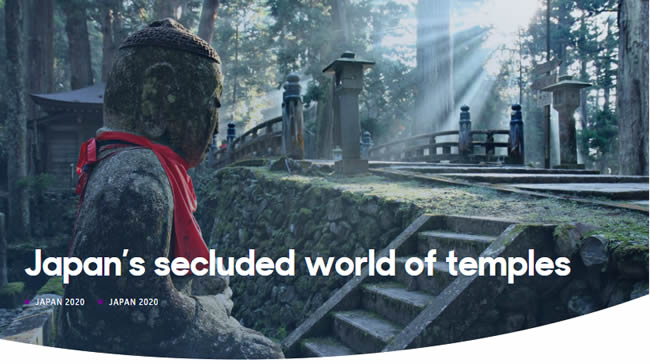先日から「Japan’s secluded world of temples – 日本の人里離れた寺の世界」を読んでいます。

・「日本の人里離れた寺の世界」(1)
・「日本の人里離れた寺の世界」(2)
・「日本の人里離れた寺の世界」(3)
・「日本の人里離れた寺の世界」(4)
・「日本の人里離れた寺の世界」(5)
・「日本の人里離れた寺の世界」(6)
・「日本の人里離れた寺の世界」(7)
・「日本の人里離れた寺の世界」(8)
・「日本の人里離れた寺の世界」(9)
・「日本の人里離れた寺の世界」(10)
Temple stays
寺に泊まるOne of the most unique experiences pilgrims and less pious visitors can have at Koya-san is staying at one of the 52 temples that operate shukubo lodgings.
巡礼者や気軽な訪問者にとって高野山ならではの体験の一つは、52の寺で営まれている宿坊体験だろう。
pious「敬虔な、信心深い、もっともらしい、立派な、実現する見込みのない」。
In the past, these would have been largely no-frills affairs, but guests at shukubo today enjoy amenities that are not too dissimilar to staying at a ryokan (Japanese inn), with tatami mat guestrooms and futon bedding.
かつては素朴な対応のところが多かったが、現在の宿坊では畳と布団の部屋で旅館(日本式宿泊施設)とは少し異なる楽しみを味わえる。
no-frills「実質本位の、過剰なサービスのない」。
One major difference, however, is that shukubo are run by monks and are set within temple grounds.
だが一番大きな違いは、宿坊は僧侶たちによる運営であり寺の敷地内にあることだ。
Another difference is the food, which is served in guestrooms by the younger monks.
もう一つの違いは、若い僧侶たちによって部屋に運ばれる食事にある。
Breakfasts and dinners feature ingredients like mountain vegetables, tofu and beans, and in the Shingon tradition, is vegetarian.
朝食と夕食は真言宗の伝統に沿った菜食で、山菜や豆腐、豆など。
“Koya-san’s vegetarian cooking was established under strict Buddhist rules prohibiting the eating of meat, and it’s been this way ever since Kukai founded Koya-san,” said Sesshu Kondo, one of the monks at the Ekoin Temple.
「高野山の菜食料理は、肉食を禁じた厳しい仏教の掟のもとで確立され、これは空海が高野山を開いた時から続くものです」と恵光院の僧侶、近藤さんは言う。
establish「設立・創立する、成立させる、打ち立てる、制定する、確立する」。
“It uses limited ingredients and simple refinements to bring out the delicate flavours and reflect the seasons.”
「限られた材料とシンプルな工夫が、素材の繊細な味わいを引き出し、季節を映し出すのです。」
宿坊では写経とか座禅も体験出来るので、警策という、肩を叩かれるとパーンと音がするアレをされてみたいという方も多いとか。
音に比べてさほど痛くはないようで、身が引き締まる気持ちになれそうです。
野菜ばかりだとお腹が空きそうですが、その空腹感も現代人にとっては、たまに必要なことかもしれませんね。
理由は単純明快!「少ないコストでしっかり楽しく学べるから」。
私自身の経験(高機能でビックリ)をびっしり書いていますので、良かったら読んでみてください。
下のバナーからどうぞ!






